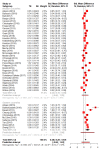Resilience Interventions Conducted in Western and Eastern Countries-A Systematic Review
- PMID: 35682495
- PMCID: PMC9180776
- DOI: 10.3390/ijerph19116913
Resilience Interventions Conducted in Western and Eastern Countries-A Systematic Review
Abstract
Previous research has demonstrated the efficacy of psychological interventions to foster resilience. However, little is known about whether the cultural context in which resilience interventions are implemented affects their efficacy on mental health. Studies performed in Western (k = 175) and Eastern countries (k = 46) regarding different aspects of interventions (setting, mode of delivery, target population, underlying theoretical approach, duration, control group design) and their efficacy on resilience, anxiety, depressive symptoms, quality of life, perceived stress, and social support were compared. Interventions in Eastern countries were longer in duration and tended to be more often conducted in group settings with a focus on family caregivers. We found evidence for larger effect sizes of resilience interventions in Eastern countries for improving resilience (standardized mean difference [SMD] = 0.48, 95% confidence interval [CI] 0.28 to 0.67; p < 0.0001; 43 studies; 6248 participants; I2 = 97.4%). Intercultural differences should receive more attention in resilience intervention research. Future studies could directly compare interventions in different cultural contexts to explain possible underlying causes for differences in their efficacy on mental health outcomes.
Keywords: anxiety; cultural psychology; depression; intervention; mental health; perceived stress; quality of life; resilience; social support.
Conflict of interest statement
The authors declare no conflict of interest.
Figures
Similar articles
-
Exercise interventions and patient beliefs for people with hip, knee or hip and knee osteoarthritis: a mixed methods review.Cochrane Database Syst Rev. 2018 Apr 17;4(4):CD010842. doi: 10.1002/14651858.CD010842.pub2. Cochrane Database Syst Rev. 2018. PMID: 29664187 Free PMC article.
-
Peer support interventions for parents and carers of children with complex needs.Cochrane Database Syst Rev. 2021 Dec 20;12(12):CD010618. doi: 10.1002/14651858.CD010618.pub2. Cochrane Database Syst Rev. 2021. PMID: 34923624 Free PMC article.
-
Shared decision-making interventions for people with mental health conditions.Cochrane Database Syst Rev. 2022 Nov 11;11(11):CD007297. doi: 10.1002/14651858.CD007297.pub3. Cochrane Database Syst Rev. 2022. PMID: 36367232 Free PMC article.
-
Music interventions for improving psychological and physical outcomes in people with cancer.Cochrane Database Syst Rev. 2021 Oct 12;10(10):CD006911. doi: 10.1002/14651858.CD006911.pub4. Cochrane Database Syst Rev. 2021. PMID: 34637527 Free PMC article.
-
Mindfulness-based psychological interventions for improving mental well-being in medical students and junior doctors.Cochrane Database Syst Rev. 2021 Dec 10;12(12):CD013740. doi: 10.1002/14651858.CD013740.pub2. Cochrane Database Syst Rev. 2021. PMID: 34890044 Free PMC article.
Cited by
-
Resilience in children of parents with mental illness, alcohol or substance misuse-An integrative review.Nurs Open. 2024 Jun;11(6):e2219. doi: 10.1002/nop2.2219. Nurs Open. 2024. PMID: 38881475 Free PMC article. Review.
-
Resilience and brain health in global populations.Nat Med. 2025 Aug;31(8):2518-2531. doi: 10.1038/s41591-025-03846-w. Epub 2025 Jul 29. Nat Med. 2025. PMID: 40731089 Review.
-
The correlation between resilience and mental health of adolescents and young adults: a systematic review and meta-analysis.Front Psychiatry. 2025 Feb 10;16:1536553. doi: 10.3389/fpsyt.2025.1536553. eCollection 2025. Front Psychiatry. 2025. PMID: 39995950 Free PMC article. Review.
-
Feasibility and efficacy of a digital resilience training: A pilot study of the strengths-based training RESIST.Internet Interv. 2023 Jul 15;33:100649. doi: 10.1016/j.invent.2023.100649. eCollection 2023 Sep. Internet Interv. 2023. PMID: 37545556 Free PMC article.
-
Relation between resilience and personality traits: The role of hopelessness and age.Scand J Psychol. 2023 Feb;64(1):53-59. doi: 10.1111/sjop.12866. Epub 2022 Sep 3. Scand J Psychol. 2023. PMID: 36057793 Free PMC article.
References
Publication types
MeSH terms
LinkOut - more resources
Full Text Sources
Medical




